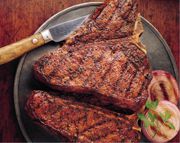A Yummy & Healthy Story about Arizona Agriculture's Beef Industry
Published
1/30/2013
In 2013, Arizona Agriculture is a $12.4 billion industry. The annual economic impact from the Arizona beef industry averages $3.2 billion.
While Arizona cattle ranchers continue to face the impacts of drought and Arizona cattle herds remain stable, cattle prices are stronger than in the recent past. The cow-calf sector has been profitable for several years and the outlook is strong. Plus, the export markets continue to strengthen especially as more open trade opportunities opened up.

The Story for Consumers is Lean Beef
Thanks to research, science continues to document a growing number of healthy benefits in lean beef. The study, Beef in an Optimal Lean Diet (BOLD), offers substantive evidence that eating lean beef daily as part of an overall healthy diet can actually lower cholesterol – and is as effective in doing so as the most recommended heart-healthy diets, which often emphasize plant proteins and limit beef.
With 29 lean beef cuts now available, Arizona families have a variety of healthy options, from steaks and roasts to lean ground beef.
The BOLD study that was first reported on in 2011 was a human clinical trial conducted by researchers at The Pennsylvania State University. Participants following BOLD diets consumed up to 5.4 oz. of lean beef daily. At the end of five weeks, they experienced a 10 percent drop in LDL (or “bad”)
Many of the BOLD menus incorporated recipes from the checkoff-funded Healthy Beef Cookbook.
Checkoff dollars were allocated to study the impact of lean beef on heart risk factors when red meat, including lean beef, became increasingly restricted in dietary recommendations for heart health. Previous checkoff-funded nutrition research suggested DASH unnecessarily restricted lean beef, according to Shalene McNeill,
“However, until the
The study is available online at http://bit.ly/BOLDAJCN.
Cattle in Arizona have a colorful and rich history and producing a quality product has always been Arizona ranch families’ first priority. According to historians, while stock raising in Arizona began as early as the 1690s with Spanish settlers and missionaries, large-scale ranching did not really take place until after the American Civil War in 1865, when conditions were more favorable partially because the U.S. Army and seasoned war veterans were now available to protect a growing nation flung out across the northern continent.
As a result, cattle numbers in Arizona quickly grew. In addition, the windmill, which was used to pump groundwater into storage ponds, and two transcontinental railroads across Arizona enabled large capital investments by businessmen seeing profit in the growing beef markets.
Arizona ranch families were managing 1.5 million head of cattle in the early 1890s, along with more than a million sheep, that roamed the Arizona landscape. Just two decades earlier cattle numbers were no more than 40,000.
While today’s cattle numbers in Arizona are not at 1.5 million as in the past, Arizona’s cattle population along with our other ranching states support a national and global market with quality beef.
Arizona Agriculture Numbers show an Impressive Beef Industry
- 3,800 ranches with cattle and calves
- Total number of cattle and calves: 870,000 head (ranked 32nd in the nation)
- 391.2 million pounds of beef were harvested in Arizona in 2010, enough to feed more than 6,000,000 people
- Cattle are raised in every county in Arizona.